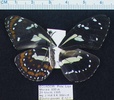Elzunia
Andrew V. Z. Brower


This tree diagram shows the relationships between several groups of organisms.
The root of the current tree connects the organisms featured in this tree to their containing group and the rest of the Tree of Life. The basal branching point in the tree represents the ancestor of the other groups in the tree. This ancestor diversified over time into several descendent subgroups, which are represented as internal nodes and terminal taxa to the right.

You can click on the root to travel down the Tree of Life all the way to the root of all Life, and you can click on the names of descendent subgroups to travel up the Tree of Life all the way to individual species.
For more information on ToL tree formatting, please see Interpreting the Tree or Classification. To learn more about phylogenetic trees, please visit our Phylogenetic Biology pages.
close boxIntroduction
Members of Elzunia are among the largest ithomiines. The species occur in mid-elevation forest in the Venezuelan, Colombian and Ecuadorean Andes, where they are engaged in Müllerian mimicry with Heliconius hecuba, Heliconius atthis and Megoleria susiana, and perhaps serve as models for female Catonephele chromis (Biblidinae).
Larvae recorded on Prestonia (Apocynaceae), like members of closely-related Tithorea and unlike most other ithomiine larvae, which feed on Solanaceae. (Neild, 2008).Characteristics
Large ithomiines with relatively short wings. Wing color black with yellow or white spots and bands. Males have a single patch of elongated androconial scales on the costal margin of the dorsal hindwings (as opposed to two in Tithorea).May be distinguished from similar-looking Heliconius species by the more triangular forewings and the bilobed distal margin of the hindwing discal cell (teardrop-shaped in Heliconius).
References
Lamas G ed. 2004. Atlas of Neotropical Lepidoptera. Checklist: Part 4A Hesperioidea - Papiionoidea. Gainesville: Scientific Publishers/Association of Tropical Lepidoptera.
Neild, A.F.E. (2008) The Butterflies of Venezuela. Part 2: Nymphalidae II (Acraeinae, Libytheinae, NYmphalinae, Ithomiinae, Morphinae), Meridian Publications, London
Title Illustrations

| Scientific Name | Elzunia humboldt bomplandii |
|---|---|
| Location | Colombia: Antioquia, Monterredondo |
| Comments | Monterredondo 8/17/2010--70073 |
| Specimen Condition | Live Specimen |
| Identified By | Kim Garwood |
| Life Cycle Stage | adult |
| View | ventral |
| Source | Elzunia humboldt bomplandii- Ventral |
| Source Collection | Flickr |
| Copyright | © 2010 Mike Chapman |
| Scientific Name | Elzunia pavonii |
|---|---|
| Location | Ecuador: Prov. Loja, Macará |
| Comments | DNA voucher E-12-1 from Brower et al. 2006. Head and thorax removed for DNA extraction. |
| Specimen Condition | Dead Specimen |
| Identified By | Andrew V. Z. Brower |
| Life Cycle Stage | adult |
| View | dorsal/ventral composite |
| Collection | Brower DNA voucher collection |
| Collector | Keith Willmott |
| Image Use |
 This media file is licensed under the Creative Commons Attribution-NonCommercial License - Version 3.0. This media file is licensed under the Creative Commons Attribution-NonCommercial License - Version 3.0.
|
| Copyright |
© 2007

|
About This Page

Middle Tennessee State University, Murfreesboro, Tennessee, USA
Correspondence regarding this page should be directed to Andrew V. Z. Brower at
Page copyright © 2011
 Page: Tree of Life
Elzunia .
Authored by
Andrew V. Z. Brower.
The TEXT of this page is licensed under the
Creative Commons Attribution License - Version 3.0. Note that images and other media
featured on this page are each governed by their own license, and they may or may not be available
for reuse. Click on an image or a media link to access the media data window, which provides the
relevant licensing information. For the general terms and conditions of ToL material reuse and
redistribution, please see the Tree of Life Copyright
Policies.
Page: Tree of Life
Elzunia .
Authored by
Andrew V. Z. Brower.
The TEXT of this page is licensed under the
Creative Commons Attribution License - Version 3.0. Note that images and other media
featured on this page are each governed by their own license, and they may or may not be available
for reuse. Click on an image or a media link to access the media data window, which provides the
relevant licensing information. For the general terms and conditions of ToL material reuse and
redistribution, please see the Tree of Life Copyright
Policies.
- First online 29 September 2006
- Content changed 24 July 2011
Citing this page:
Brower, Andrew V. Z. 2011. Elzunia . Version 24 July 2011 (under construction). http://tolweb.org/Elzunia/27577/2011.07.24 in The Tree of Life Web Project, http://tolweb.org/









 Go to quick links
Go to quick search
Go to navigation for this section of the ToL site
Go to detailed links for the ToL site
Go to quick links
Go to quick search
Go to navigation for this section of the ToL site
Go to detailed links for the ToL site